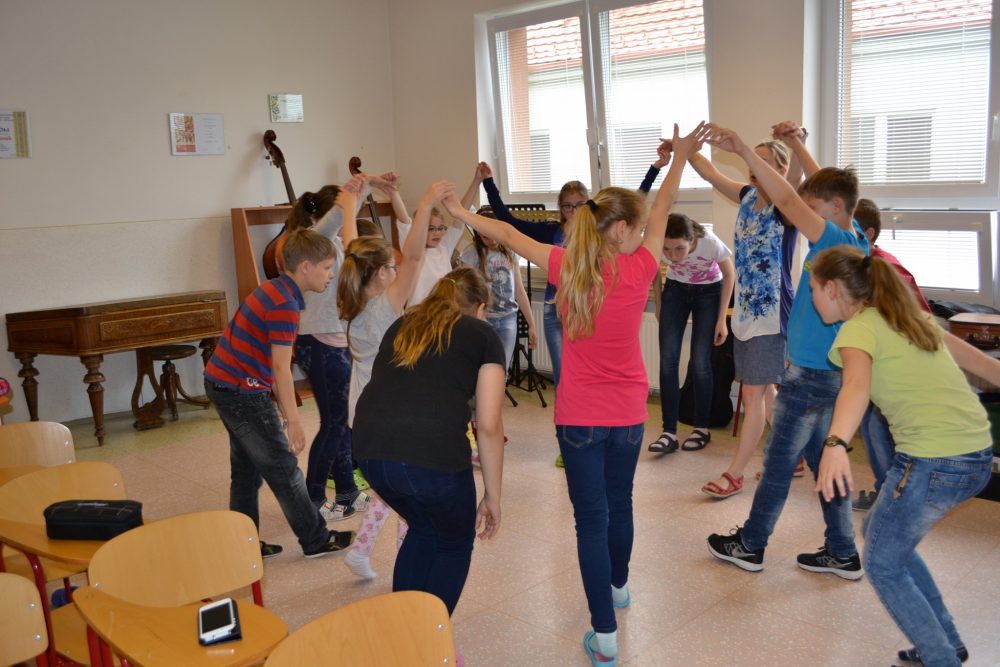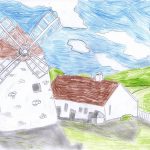Summary
The following block brings the stimuli to playful activities inspired by the environment of the country mill. The fantasy and intuition of the children is inspired by the character of the place and surrounding countryside and the work in the mill. The pupils do rhythmical, musically-movement and dance plays in which they use rhymes and songs adequate for the given topic. Creative elements penetrate musically-movement and dance elements, they are the part of the work with texts, their rhythmical structure and content. The improvisation within rhythmical and musically-movement plays helps the development of creative thinking and the sense of a music form.
The imagination of children might be intensified by the pictures of the country mill or the visits to such places. The walks in the country, art activities etc. are the suitable means of interest and creative attitude stimulation of pupils in the area of activities inspired by nature (Module 3).
The children play the “mill wheel” in a circle. They clap the written rhythmical figures while they develop metre-rhythmical sense, sense of tempo, music memory, readiness and fantasy. At the same time, they learn to write their rhythmical imaginations into notes. First, they are led to perception of metric pulsation, then they distinguish between accented and unaccented beat in the bar and on this basis they distinguish the metro-rhythmical structure of the form. They interpret the rhythmical figures in groups (or individually) in a row in unison or in the form of polyphony. The canon represents another polyphonic variant. The development of creative abilities in the area of rhythm is intensified in the form of rondo – the main idea (a) is represented by a rhythmical figure, couplets (b, c etc.) are created by the pupils themselves, using their music imagination.
References: Module 3,
Duration: 135 min
Key words creativity & entrepreneurship: Sensibility for problems diversity, Working in teams (music groups), Originality of ideas, Flow of ideas, Persistence, Development of ideas and solutions, Transformation in organization, Finding of opportunities, Failure tolerance
Description
Step 1
We motivate the pupils to perceive metric pulsation by “clopping” of the mill wheel. They stand in a circle and express the regular “clopping” by clapping. One child is a percussionist who gives tempo. The others adequately respond to his acceleration or slowing down (see the methodological sheet for the teachers, mill wheel 1, M3B3ML1e)
Step 2
Through the play with three-beat rhythms, the pupils are led to the perception of strong and weak beat in the bar and rhythmical readiness. They express the accented (strong) beat e. g. by slapping, the weak beat by clapping. The percussionist holds the same tempo. In the circle, there should be an even number of the pupils, so that during repetitions there is a different structure of strong and weak beats (see the methodological sheet for the teachers, mill wheel 2, M3B3ML1e).
Step 3
Every child creates a rhythmical structure in a 3/4 time. The percussionist starts the play, he gives the metre, gradually, the individual pupils follow. The metric pulsation should not be broken. If the pupils are not able to create their own rhythmical model, they might use the examples from the methodological sheet (see the methodological sheet for the teachers, mill wheel 3, M3B3ML2e).
Step 4
This is the same activity done in duet (see the methodological sheets for teacher, mill wheel 4, M3B3ML2e).
The variant of polyphonic interpretation is canon. We divide the pupils into two (three) groups. In the rhythmical record, we mark the place where we start and we realize it in the form of canon (see the methodological sheet for the teachers, mill wheel 5 – canon, M3B3ML3e).
Step 5
The rhythmical rondo play. The pupils work in 4 groups marked by the letters a, b, c, d. Every group of children creates a rhythmical two bars in a 3/4 time. They take turns during the play, according to the rondo principle (see the methodological sheets for the teachers, mill wheel 6 – rondo, M3B3ML3e).
Step 6
Musically-movement and dance plays with the songs Jsou mlynáři chlapi, chlapi and Běži voda, běži. First, the pupils learn to sing both songs.
Jsou mlynáři chlapi, chlapi [The Millers Are the Fellows (the song about the millers, their work in the mill)]

Phonetic transcription: /jsɔʊ mlɪna: r̝̊ɪ xlapɪ xlapɪ, gdɪʒ jɪm mli:nɪ klapɪ, jsɔʊ mlɪna: r̝̊ɪ xlapɪ xlapɪ, gdɪʒ jɪm mli:nɪ jdɔʊ. Gdɪʒ jɪm mli:nɪ nɛxcɔʊ klapat, zatʃnɔʊ jakɔ ʃɛlmɪ plakat, jsɔʊ mlɪna: r̝̊ɪ xlapɪ xlapɪ, gdɪʒ jɪm mli:nɪ jdɔʊ/.
Běži voda, běži [The Water Runs (love song about lost love)]

Phonetic transcription: /bjɛʒi: vɔda bjɛʒi:, pɔ kamɛni:x ʃʊsti:, zkazal mnjɛ mu:j mɪli:, ʒɛ mɛ ɔpʊsti:, dlɛ slɔvɛtʃka jɛdnɛhɔ pɔzbɪla sɛm mɪle:hɔ/.
The boys work with a two-beat song Jsou mlynáři chlapi, chlapii which is connected to male activities in the mill. While singing the song accompanied by the cimbalom band, they create their own imaginations and fantasies of movement creation adequate for the song content.
Likewise, the girls are engaged in interpretation of a three-beat dance song Běži voda, běži which comes from north-east Moravia (the region of Lachia) and is connected with “old-time” dance. The girls with their dance movements respond to music and content character of the song in the circle. Their singing and dance manifestation is accompanied by a cimbalom band.
Competencies
The pupils are able to:
- know well the rhythmical notation, they are able to interconnect it with the body play
- improvise within simple music forms – rondo, canon
- realize rhythmical polyphony
- express the content of the song using elementary movement
- coordinate movement elements with the played music
Materials
- The notation of the song Jsou mlynáři chlapi, chlapi.
- The notation of the song Běži voda, běži. In F. Sušil (71951). Moravské národní písně s nápěvy do textu vřaděnými [Moravian National Songs with the Melodies Integrated into the Text]. Praha: Nakladatelství Vyšehrad, No. 455.
- The methodological sheets for the teachers: M3B3ML1e, M3B3ML2e, M3B3ML3e
Module Overview
|


